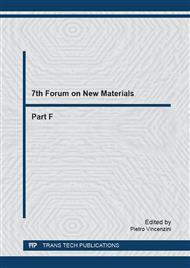[1]
L. Kock, C.C. van Donkelaar, K. Ito, Tissue engineering of functional articular cartilage: The current status, Cell Tissue Res. 347 (2012) 613-627.
DOI: 10.1007/s00441-011-1243-1
Google Scholar
[2]
T.J. Klein, J. Malda, R.L. Sah, D.W. Hutmacher, Tissue engineering of articular cartilage with biomimetic zones, Tissue Eng. Part B Rev. 15 (2009) 143-157.
DOI: 10.1089/ten.teb.2008.0563
Google Scholar
[3]
S.P. Grogan, S.F. Duffy, C. Pauli, J.A. Koziol, A.I. Su, D.D. D'Lima, M.K. Lotz, Zone-specific gene expression patterns in articular cartilage, Arthritis Rheum. 65 (2013) 418-428.
DOI: 10.1002/art.37760
Google Scholar
[4]
I. Gadjanski, K. Spiller, G. Vunjak-Novakovic, Time-dependent processes in stem cell-based tissue engineering of articular cartilage, Stem Cell Rev. 8 (2012) 863-881.
DOI: 10.1007/s12015-011-9328-5
Google Scholar
[5]
C.S. Bahney, C.W. Hsu, J.U. Yoo, J.L. West, B. Johnstone, A bioresponsive hydrogel tuned to chondrogenesis of human mesenchymal stem cells, FASEB J. 25 (2011) 1486-1496.
DOI: 10.1096/fj.10-165514
Google Scholar
[6]
J.A. Andrades, S.C. Motaung, P. Jimenez-Palomo, S. Claros, J.M. Lopez-Puerta, J. Becerra, T.M. Schmid, A.H. Reddi, Induction of superficial zone protein (SZP)/lubricin/PRG 4 in muscle-derived mesenchymal stem/progenitor cells by transforming growth factor-beta1 and bone morphogenetic protein-7, Arthritis Res. Ther. 14 (2012).
DOI: 10.1186/ar3793
Google Scholar
[7]
E. Coates, J.P. Fisher, Gene expression of alginate-embedded chondrocyte subpopulations and their response to exogenous IGF-1 delivery, J. Tissue Eng. Regen. Med. 6 (2012) 179-192.
DOI: 10.1002/term.411
Google Scholar
[8]
F. Las Heras, H.K. Gahunia, K.P. Pritzker, Articular cartilage development: A molecular perspective. Orthop. Clin. North. Am. 43 (2012) 155-171.
DOI: 10.1016/j.ocl.2012.01.003
Google Scholar
[9]
E.E. Coates, J.P. Fisher, Phenotypic variations in chondrocyte subpopulations and their response to in vitro culture and external stimuli, Ann. Biomed. Eng. 38 (2010) 3371-3388.
DOI: 10.1007/s10439-010-0096-1
Google Scholar
[10]
N.T. Khanarian, N.M. Haney, R.A. Burga, H.H. Lu, A functional agarose-hydroxyapatite scaffold for osteochondral interface regeneration, Biomaterials 33 (2012) 5247-5258.
DOI: 10.1016/j.biomaterials.2012.03.076
Google Scholar
[11]
S. Moeinzadeh, D. Barati, X. He, E. Jabbari, Gelation characteristics and osteogenic differentiation of stromal cells in inert hydrolytically degradable micellar polyethylene glycol hydrogels, Biomacromolecules 13 (2012) 2073-(2086).
DOI: 10.1021/bm300453k
Google Scholar
[12]
W. Xu, J. Ma, E. Jabbari, Material properties and osteogenic differentiation of marrow stromal cells on fiber-reinforced laminated hydrogel nanocomposites, Acta Biomater. 6 (2010) 1992-(2002).
DOI: 10.1016/j.actbio.2009.12.003
Google Scholar
[13]
O. Karaman, A. Kumar, S. Moeinzadeh, X. He, T. Cui, E. Jabbari, Effect of surface modification of nanofibers with glutamic acid peptide on calcium phosphate nucleation and osteogenic differentiation of marrow stromal cells, J. Tissue Eng. Regen. Med. 10 (2016).
DOI: 10.1002/term.1775
Google Scholar
[14]
V. Dexheimer, S. Frank, W. Richter, Proliferation as a requirement for in vitro chondrogenesis of human mesenchymal stem cells, Stem Cells Dev. 21 (2012) 2160-2169.
DOI: 10.1089/scd.2011.0670
Google Scholar
[15]
H. Akiyama, V. Lefebvre, Unraveling the transcriptional regulatory machinery in chondrogenesis, J. Bone Miner. Metab. 29 (2011) 390-395.
DOI: 10.1007/s00774-011-0273-9
Google Scholar
[16]
B.S. Yoon, D.A. Ovchinnikov, I. Yoshii, Y. Mishina, R.R. Behringer, K.M. Lyons, BMPR1a and BMPR1b have overlapping functions and are essential for chondrogenesis in vivo. Proc. Natl. Acad. Sci. U. S. A. 102 (2005) 5062-5067.
DOI: 10.1073/pnas.0500031102
Google Scholar


